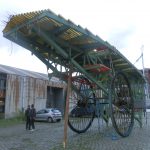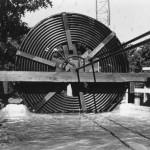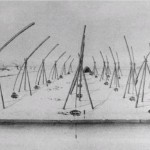“Modern wind farms comprised of horizontal-axis wind turbines (HAWTs) require significant land resources to separate each wind turbine from the adjacent turbine wakes. This aerodynamic constraint limits the amount of power that can be extracted from a given wind farm footprint. The resulting inefficiency of HAWT farms is currently compensated by using taller wind turbines to access greater wind resources at high altitudes, but this solution comes at the expense of higher engineering costs and greater visual, acoustic, radar and environmental impacts.”
“We investigated the use of counter-rotating vertical-axis wind turbines (VAWTs) in order to achieve higher power output per unit land area than existing wind farms consisting of HAWTs. Full-scale field tests of 10-m tall VAWTs in various counter-rotating configurations were conducted under natural wind conditions during summer 2010. Whereas modern wind farms consisting of HAWTs produce 2 to 3 watts of power per square meter of land area, these field tests indicate that power densities an order of magnitude greater [21 to 47 watts] can potentially be achieved by arranging VAWTs in layouts that enable them to extract energy from adjacent wakes and from above the wind farm.”
“The results suggest an alternative approach to wind farming that has the potential to concurrently reduce the cost, size, and environmental impacts of wind farms.”
Read more: ‘Potential order-of-magnitude enhancement of wind farm power density via counterrotating vertical-axis wind turbine arrays’, John O. Dabiri. Introduction. Research paper (pdf). Via Ecogeek.





